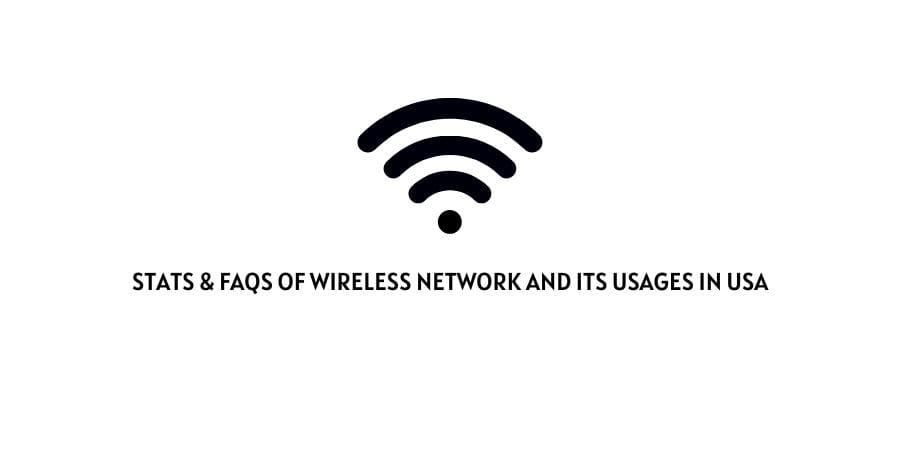
Wireless networking is a key part of the modern world. It allows people to work from anywhere and enable businesses to deliver services without costly infrastructure. Wireless networks use radio waves to transmit information and connect easily to mobile devices or other wireless networks.
This article will explore stats & FAQs of wireless network usages in USA.
The good news is that there are many places in the US to get a good internet connection. You just need to know where to look.
If you’re looking for a state with great Wi-Fi, New Jersey, San Francisco, CA is your place. It has some of the fastest and most reliable wireless networks in the country.
What is a wireless network?
Wireless networks are networks that use radio waves to transfer data. WIFI is the wireless network standard short for “wireless fidelity”.
WIFI is a technology that uses radio waves to transmit and receive data. It has been around for decades, but it has only recently become popular due to its convenience and effectiveness.
What are the benefits of wireless networks?
Wireless networks are becoming more and more popular, especially for those who work from home. They provide convenience and flexibility, especially for those who are constantly on the go.
Wireless networks have many benefits to offer, such as increased productivity and increased mobility. They also allow you to use your laptop or mobile phone anywhere in your house or office.
The most significant benefit of wireless networks is the flexibility they offer. Wireless networks allow you to work from home or on the go without being restricted by cables or wires.
What state In The USA has the best WIFI?
As mentioned on RouterCTRL, New Jersey has the best Internet. That is only one of the many benefits our state provides. Other outstanding features include:
- Low taxes.
- Access to a port.
- A concentration of high-yielding farms.
- Some of the most beautiful forests in America.
New Jersey has the nation’s best Internet, with a speed of 52 Mbps on average. This is nearly twice as fast as the national average of 27.6 Mbps and close to four times faster than the state average of 12 Mbps.
New Jersey is the best state for Wi-Fi. It has a high density of wireless access points, and it’s also one of the few states that don’t restrict wireless use.
New Jersey has the nation’s best Internet speed, according to a recent study by Ookla Speedtest.com. Out of all 50 states, New Jersey ranks number one in average download speed at 52 Mb/s and upload speed at 27 Mb/s.
The state also has a high density of wireless access points, with about 860 hotspots per square mile, making it easy for people to get online no matter where they are.
There are many factors that influence the quality of a state’s WIFI. These include terrain, weather, population density, and the number of people who use Wi-Fi.
The best states for WIFI are those that have low population density, high terrain, and great weather. States like Montana and Idaho seem to be ideal for this reason.
Which states In USA have the most reliable WIFI?
We all know that WIFI is a technology that is constantly improving. With the introduction of 5G, we will be able to get faster and more reliable Internet.
However, for now, we can use this data to find out which states have the most reliable WIFI service.
- Arkansas
- California
- Colorado
- Florida
- Georgia
- Illinois
- Kansas
- Louisiana
- Maryland
Which states In USA have the most free WIFI?
The answer to this question is very simple – it’s the state of California!
California has more than 4.1 million public access hotspots, which is the most in the country.
In addition to its high number of WIFI hotspots, California has a large population of people who can use these hotspots for free.
Why do companies use wireless networks?
Wireless networks are used in many different ways. They can be used for public Wi-Fi hotspots, corporate networks, and wireless backhaul.
A wireless network is an easy way to provide internet access for a large number of people without the need for a physical connection. It is also faster than other types of internet connections.
Companies use wireless networks to make it easier for their employees to access the Internet in a convenient location. They also use them in order to save on infrastructure costs and provide better connectivity with their customers or partners.
Which countries use wireless networks the most?
There are some countries that use wireless networks more than others. This is because these countries have a higher number of mobile subscriptions and internet subscriptions.
The United States has the highest number of mobile subscriptions in the world, with 552 million subscribers in 2021. China follows this with 438 million, India with 339 million, and Brazil with 297 million.
What are the drawbacks of wireless networks?
Wireless networks are a great way to connect to the Internet and share files. But, as with all technologies, there are drawbacks to using them.
There is no guarantee that a wireless network will be available in areas you need it the most.
They can be disrupted by electromagnetic radiation from nearby devices such as microwave ovens and cell towers.
Additionally, there is always a chance that your device could be hacked or infected with malware if you connect to an unsafe network.
How fast can a wireless network be?
Wireless networks can be high-speed, but there are certain factors that can affect their speed.
Wireless networks are faster than ever before, but they still have their limitations. Wireless networks are only as fast as the slowest device connected to it.
Wireless networks also don’t work well in dense areas and other places with a lot of metal objects, such as a stadium or convention centers.
The wireless network speed is determined mainly by three factors:
- The wireless network’s distance from the wireless router
- The wireless router’s power output
- The type of wireless network technology used
The speed of a wireless network is measured in bits per second (bps). The bit rate is the amount of data that can be transmitted in one second. To calculate the speed, you need to divide the number of bits by sharing those bits.
The speed of a wireless network is also essential because it determines how quickly your data can be accessed and downloaded.
If your wireless network’s speed is too slow, you will experience lagging or buffering when streaming videos or other media content.
What is the average speed of a wireless network?
A wireless network’s speed is measured in megabits per second. The average rate of a wireless network is about 54 Mbps.
This is a common question that people ask themselves when they are trying to make their Wi-Fi faster.
There are some factors that affect the speed of a wireless network, such as the distance between the router and your device, the number of devices connected to it, and how many walls or obstructions there are in between them.
Some of the factors that affect the speed of a wireless network are interference, distance, and bandwidth.
This is high enough to support streaming HD video and other data-intensive tasks such as gaming or file sharing.
Can I use a public Wi-Fi hotspot for my personal use?
Yes, but only if the country allows it. Some countries have strict rules on using public Wi-Fi hotspots and require users to log in with a VPN before connecting to the Internet.
Many people usually share public Wi-Fi hotspots, so you don’t have to worry about stolen personal data. However, some countries have different rules on using public Wi-Fi hotspots.
Like This Post? Checkout More
